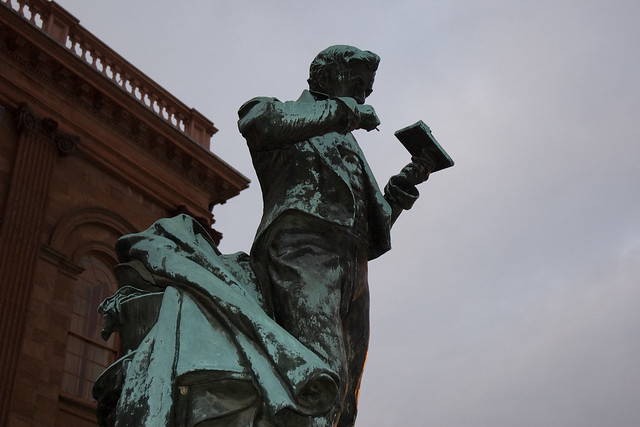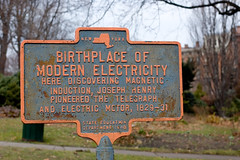 I suppose that Albany residents could be forgiven for not knowing that the man who figured out how to create an electromagnet, by winding wire around a magnet and running a current through it, figured this all out in Albany. I guess it could have escaped our attention that the man who created this invention (capable of lifting 3500 pounds — it was no toy) did so while teaching snotty-nosed schoolboys at the Albany Academy, in the building that still stands in Academy Park across from the Capitol and City Hall. And since we’re generally fuzzy on the principles of electricity, the fact that he also discovered electrical induction, and created the first telegraphic signal, and created some of the first elements of electric motors, can easily get lumped into a single sentiment: “He did a lot of electric stuff.” And since it had nothing to do with electricity, it would be easy to forget that he also developed meteorology into a science and drew up the first thing we’d recognize as a weather map. But when that same person from Albany also became the first Secretary of the Smithsonian Institution, an institution that anyone who has made it through the third grade knows and understands, then the thought that almost no one in Albany knows who Joseph Henry was is absolutely maddening.
I suppose that Albany residents could be forgiven for not knowing that the man who figured out how to create an electromagnet, by winding wire around a magnet and running a current through it, figured this all out in Albany. I guess it could have escaped our attention that the man who created this invention (capable of lifting 3500 pounds — it was no toy) did so while teaching snotty-nosed schoolboys at the Albany Academy, in the building that still stands in Academy Park across from the Capitol and City Hall. And since we’re generally fuzzy on the principles of electricity, the fact that he also discovered electrical induction, and created the first telegraphic signal, and created some of the first elements of electric motors, can easily get lumped into a single sentiment: “He did a lot of electric stuff.” And since it had nothing to do with electricity, it would be easy to forget that he also developed meteorology into a science and drew up the first thing we’d recognize as a weather map. But when that same person from Albany also became the first Secretary of the Smithsonian Institution, an institution that anyone who has made it through the third grade knows and understands, then the thought that almost no one in Albany knows who Joseph Henry was is absolutely maddening.
Joseph Henry was born in Albany to Scottish immigrants William and Ann Henry in 1797. When his father died, Joseph was sent to live with his grandmother in Galway, New York. He went to school there and was apprenticed to a watchmaker and silversmith. In 1819, at 22 years of age, he was granted free admission to the Albany Academy, intending to go into medicine and supporting himself through teaching and tutoring. He became an assistant surveyor on a state road project and turned his mind toward engineering. He continued his studies and quickly became a teacher as well as a student, and in 1826 was appointed Professor of Mathematics and Natural Philosophy at the Academy.

Birthplace of Modern Electricity marker (Photo credit: carljohnson)
Henry went on to teach at Princeton. In addition to inventing more and more of the essential components of modern electricity, he studied sunspots, and acoustics, and any number of other things. Alexander Graham Bell sought his advice in developing the telephone. After he died, John Phillip Sousa wrote “The Transit of Venus March” to commemorate the unveiling of a memorial statue. That statue in front of the original Smithsonian building? It’s not Smithson — it’s Joseph Henry.
Oh, yeah, did I mention he was from Albany?
Another local blogger has a nice little summary with some things that I missed. Joseph Henry did not spend a lot of time chilling out, it would seem.


Leave a Reply